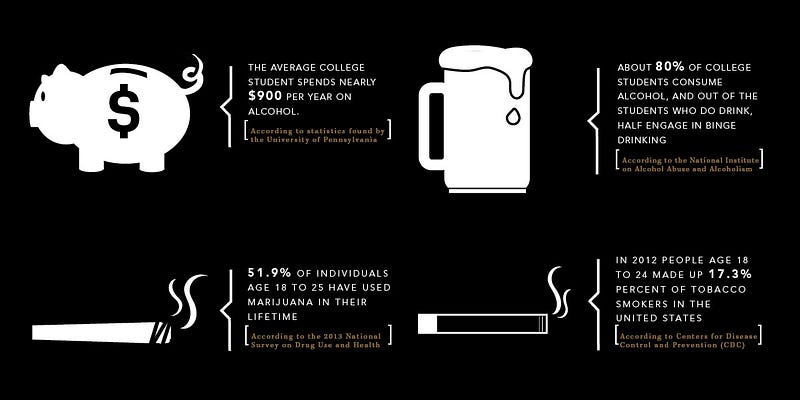Life on the Straight Edge
Modified life for a wider mindset
STORY BY KATELYN DOGGETT
photos by Jake Parrish
Symbolizing abstinence from all drugs and alcohol, black “Xs” mark the hands of some people who are straight edge.
In a dimly lit room filled with a crowd of rowdy teenagers and young adults, five men take the stage. The lead singer grabs the microphone roughly. He begins yelling almost inaudible lyrics at the impatient crowd whose faces are masked in shadows. The next 46 seconds spark a worldwide subculture known as straight edge, which will continue for years to come.
“I’m a person just like you, but I’ve got better things to do than sit around and smoke dope,” shouts Ian MacKaye, lead singer of the hardcore punk band Minor Threat. While thrashing his body around during a performance of the band’s 1981 song “Straight Edge,” MacKaye helped create an idea that would ignite a lifestyle for many.
Being straight edge is a self-declared, intentional choice where adherents limit substances they put into their body, says nine-year straight edge Spencer Adams of Seattle. While limitations vary within the culture, most straight edge individuals refrain from consuming alcohol, tobacco and recreational drugs. For some, the lifestyle includes forgoing engagement in promiscuous sexual activity, avoiding caffeine, practicing veganism and rejecting prescription medications.
After getting in trouble for doing graffiti at the age of 13, Adams, now 22, went through a “personal renaissance” in which he thought about who he wanted to be, deciding to avoid mind-altering substances, he says.
“In eighth grade a bunch of my friends and I were hanging out in a basement and stealing beers from one of their parents,” Adams says. “I remember being uncomfortable and revolted by the idea of it. That might have been the moment where I wanted to avoid all of it entirely. “
Some people draw X’s on their hands with black marker to represent being straight edge, a tradition derived from the practice of bartenders drawing marks on underage hands to signify they are too young to drink, Adams says.
There are magazines, clothing companies and bands dedicated to the straight edge lifestyle; adherents can go to these for inspiration and to find comfort knowing there are others living similar lives.
For hardcore punk fan Ted Kornegay, 20, music influenced his decision to live a straight edge life avoiding alcohol, drugs and caffeine. In middle school and high school Kornegay listened to bands that identified as straight edge, he says. He remembers the moment he first heard Minor Threat’s song “Straight Edge” and thought it embodied the meaning of being punk rock — thinking for yourself and making your own decisions.
Music still remains an essential part in many straight edge lives, but it has grown beyond the punk scene, Adams says. He likes that the hardcore scene provides music with a message, but that he chose to disassociate himself with that scene and made the choice to live his life without drugs and alcohol independent from the movement.
“I’ve learned that over time, alcohol and drugs are just another distraction from what life has to offer. Life’s too short to spend it not mentally present,”
Being straight edge has unintentional benefits, Adams says. If someone doesn’t drink, that’s more money in his or her pocket, Adams says. The average college student spends nearly $900 per year on alcohol, according to the University of Pennsylvania.
About 80 percent of college students consume alcohol, and half of those students engage in binge drinking, according to statistics found by the National Institute on Alcohol Abuse and Alcoholism. Also, around 51.9 percent of individuals age 18 to 25 have used marijuana in their lifetime, according to the 2013 National Survey on Drug Use and Health. Despite these statistics, straight edge individuals still avoid drinking after they are of legal age to do so.
The straight edge movement is about self-respect and utilizing one’s ability to make a conscious decision of rejecting the societal norm of intoxication, Kornegay says. While straight edge people keep their bodies free of harmful substances, it’s not merely about the health benefits.
“I started on a lot of introspection and soul searching really early because I was idle,” Adams says. “I’m four years ahead of a lot of people who started drinking in high school.”
Seeing his peers become involved with alcohol helped Kornegay realize he wasn’t interested in living that way. He considered himself straight edge for eight years until October 2013 after starting at Western. After experimenting with drugs and alcohol, he hit a breaking point in August 2014. He realized that by drinking and getting high he didn’t feel like himself anymore, arousing the decision to live a sober life again, he says.

Adams encourages taking time to cut out drinking or smoking for a change of perspective but also likes to keep an open mind to things he abstains from. Similar to Kornegay, Adams says he took his first drink of alcohol at the age of 19, but soon reverted back to his straight edge lifestyle and only on very rare occasions has an alcoholic drink.
“When you remove something that you rely on, or are used to, it opens up space to do something else or reflect on that things place in your life,” Adams says.
Not only will those who attempt to go substance free reap the health and financial benefits of what it’s like being straight edge, but the individual may realize what is truly important in their lives without the crutch of alcohol, Adams says.
As Kornegay is rocked from side to side — — in a sweaty crowd at a punk show, his mind remains clear and steady. He may be one of the few sober people who isn’t drinking a beer, or taking a hit from a joint, he says, but he finds himself aware of his surroundings. Enjoying life and music not masked by a dazed illusion.
